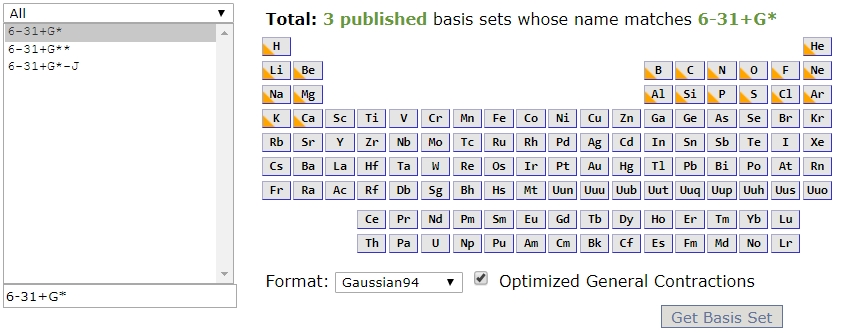Mixed Basis Sets with Gaussian
How to implement mixed basis sets
Computational jobs that require a single basis set to describe all the atoms in the molecule are straightforward. In the route line, a method is followed by a single basis set designation separated by a forward slash.
# <method>/<basis>However, when using basis sets not incorporated in the Gaussian software package or when using mixed basis sets (that is, using multiple basis sets to define certain atoms in the molecule), the GEN or GENECP keyword must be used in place of <basis> and a basis set must be defined below the molecule specification section of the input file. Note: GENECP is used when using a basis set that implements an effective core potential (ECP). This is particularly necessary when dealing with organometallic systems where a specialized basis set is used for the metal while common basis sets are used for main group elements.
Obtaining a Basis Set at EMSL Basis Set Exchange
Many basis sets for atoms can be obtained from the EMSL Basis Set Exchange website. Open this page now to use for the remainder of this tutorial.
Imagine a fictitious molecule that contains C, H, O, and Pt. You decide to use a 6-31+G* basis set. On the EMSL page, find this basis set in the list located on the left and select it. You can type the name in to narrow the search results. You should see the following:

The elements on the periodic table that this basis set exists for have a gold triangle in the bottom left. Notice how C, H, and O have basis functions defined by the 6-31+G* basis set, however, none of the transition metals including Pt do. Select the C, H, and O elements (the selected boxes turn green) and in the “Format:” drop-down menu, select “Gaussian94”. The “Optimized General Contractions” can be checked. Finally, click the “Get Basis Set” button. A new window will appear.
Before moving on, deselect all atoms and select the Pt atom only. The list on the left automatically omits any basis set that does not exist for Pt. For this tutorial, find the “modified LANL2DZ” basis set for Pt and select it in the list. Finally, click “Get Basis Set” after ensuring that the Format is set to “Gaussian94”.
Dissecting the Basis Set File
6-31+G* Basis Set File
Click here to see the contents of what is printed in the new window for the 6-31+G* basis set for C, H, and O atoms.
Head Matter (lines 1-55) These are lines that begin with a “!” and are simply head matter that gives information about the basis set you’ve chosen.
H Atom Basis Functions (lines 60-66) These lines contain the information for the basis functions that are for the H atom as defined by the 6-31+G* basis set.
C Atom Basis Functions (lines 68-85) These lines contain the information for the basis functions that are for the C atom as defined by the 6-31+G* basis set.
O Atom Basis Functions (lines 87-104) These lines contain the information for the basis functions that are for the O atom as defined by the 6-31+G* basis set.
modified LANL2DZ Basis Set File
Click here to see the contents of what is printed in the new window for the modified LANL2DZ basis set for Pt.
Head Matter (lines 1-5) These are lines that begin with a “!” and are simply head matter that gives information about the basis set you’ve chosen.
Pt Atom Basis Functions (lines 10-37) These lines contain the information for the basis functions that are for the Pt atom as defined by the modified LANL2DZ basis set.
Pt Atom Effective Core Potential (lines 48-84) These lines contain the information for the effective core potential (ECP) that are for the Pt atom as defined by the modified LANL2DZ basis set.
Building a Gaussian Input File with a Mixed Basis Set
Click here to see an example Gaussian input file implementing our mixed basis set. The contents of this file is discussed below.
Lines 1-13 contain the normal Gaussian input syntax. Note the route line (line 4) contains the keyword GENECP instead of the name of a basis set. GENECP was chosen because 1.) we have decided to implement a mixed basis set and 2.) an ECP is being included (for Pt). If no ECP is being used, GEN is the appropriate keyword.
Below the atom specification block is a blank line (line 13). Following this is the section that defines the basis functions for all the atoms. The order does not matter. Here I’ve chosen to list the basis functions for H first, followed by C, O, and Pt. Each set of basis functions are separated by four asterisks. I simply pasted in the appropriate lines from the EMSL Basis Set files obtained earlier.
The basis function section must always be terminated by a blank line (line 89).
Since the modified LANL2DZ basis set contains an ECP for Pt, we must now include this in the ECP section that follows the basis function section (lines 90-126). Again, I have pasted in the bottom part of the basis set output from EMSL. Terminate the section with a single blank line (line 127).
You now have implemented a mixed basis set where there are basis functions for each atom given in the input file.